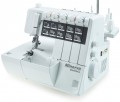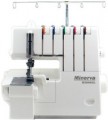Max. stitch length
The maximum stitch length that the sewing machine can sew. This parameter is important for working with dense thick fabrics: the stronger the fabric, the longer the seam used for it. Accordingly, the longer the stitch (
5 mm or more), the better the machine is suitable for working with similar fabrics.
Max. stitch width
The maximum stitch width provided by a sewing machine.
Most modern sewing machines are capable of working not only with the simplest longitudinal seam (when punctures with a needle occur strictly one after another), but also with seams that cover a certain width - for example, zigzag and various decorative ones. And in overlockers, such opportunities are generally available by definition.
The larger the maximum stitch width, the correspondingly wider the machine’s ability to work with specific types of seams (all other things being equal). An indicator of up to 5 mm is typical mainly for entry-level devices, 5 - 7 mm - average, 7 mm and more - advanced.
Sewing speed
The maximum sewing speed provided by the sewing machine. In the vast majority of models, this parameter can be adjusted, so that, if necessary, you can sew at a lower speed.
The more stitches per minute the machine makes, the higher its productivity, and the better it is suitable for large volumes of work. At the same time, note that high speed has a corresponding effect on price and power consumption, and it is not always required. Detailed recommendations on choosing the optimal speed for certain types of work can be found in special sources.

